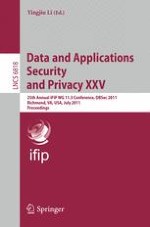This book constitutes the refereed proceedings of the 25th IFIP WG 11.3 International Conference on Data and Applications Security and Privacy, DBSec 2011, held in Richmond, VA, USA, in July 2011. The 14 revised full papers and 9 short papers presented together with 3 invited lectures were carefully reviewed and selected from 37 submissions. The topics of these papers include access control, privacy-preserving data applications, data confidentiality and query verification, query and data privacy, authentication and secret sharing.
